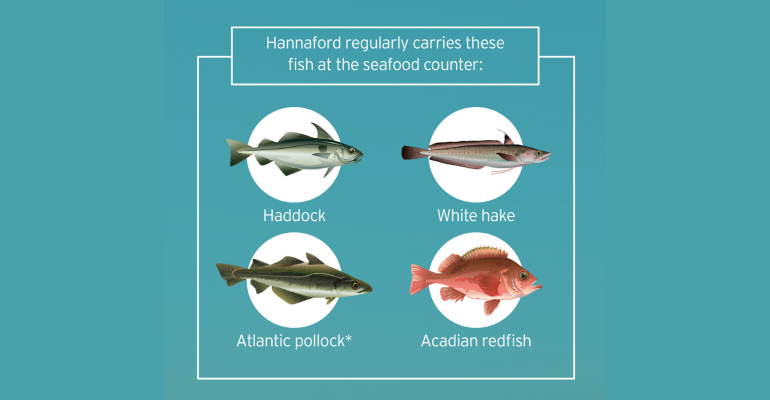Hannaford Supermarkets has introduced a new “Gulf of Maine Seafood” guide, which the grocer says is designed to help familiarize people new to the U.S. with fresh local offerings while further developing the market for sustainable seafood.
The guide, which was developed by the Gulf of Maine Research Institute (GMRI) and translated by House of Languages in Portland, is now available at the seafood counter at all Hannaford stores, as well as online.
It is currently available in six languages — Arabic, Chinese, English, French, Portuguese, and Spanish.
Featuring colorful images of whole fish and shellfish, the guide offers information about local seafood offerings, including flavor profiles, health attributes, and cooking tips.
Shoppers will find guidance on a variety of whitefish, including haddock, pollock, and white hake – all available in New England waters. Monkfish and spiny dogfish are called out for denser meat and strong flavors that hold up well in stews, roasting, and grilling. Acadian redfish, black sea bass, and scup are noted as particularly good for cooking whole with small bones.
“We know many members of local immigrant communities come from parts of the world that eat much more seafood than Americans do, and through this project we learned more about their interest in local seafood,” said Kyle Foley, sustainable seafood director at GMRI.
The guide came to life as a result of learnings from focus groups with local immigrants. GMRI worked with Hannaford, Good Shepherd Food Bank, and Portland Adult Education to organize focus groups comprised of immigrants from four continents. Khadija Ahmed, a staff member with Good Shepherd Food Bank and an emigree from the Democratic Republic of the Congo approximately 20 years ago, facilitated the focus groups.
Approximately 90% of the participants said they liked and wanted to eat more seafood than they currently do.
The focus groups validated what Nathan Jewell, a seafood merchandiser at Hannaford, heard at stores: that immigrant customers were confident cooks, but did not have an easy way to relate what they saw in Northeast seafood cases with the seafood they had grown up with in Africa, South America, the Middle East, or the Caribbean.
“We learned of the need for a guide or an orientation to the seafood that is available locally. The groups also helped us understand their preferences – importance of affordability, frozen options, and ways to better understand the fresh seafood offered locally,” Jewell said. “Many benefits came from the work to develop the guide. We understand the needs of our customers and our communities better and we are seeing new potential for Gulf of Maine seafood, too. I think all the partners learned some things that will help develop the market for Gulf of Maine seafood.”
The new seafood guide is the latest development in a long-standing partnership between the Gulf of Maine Research Institute and Hannaford. In 2010, Hannaford began work with the research group to vet and audit all seafood products sold at its stores on a continuous basis to ensure they are fully traceable, come from responsible sources, and meet strict criteria in Hannaford’s seafood sourcing policy, which requires all seafood products sold at its stores to meet key sustainability criteria.
For each seafood product, information is required from suppliers, including how and where fish were caught or farmed and whether the fish is sourced from a fishery or farm that is certified to a Global Sustainable Seafood Initiative-benchmarked standard, engaged in a Fishery Improvement Project, or assessed as low risk by the Gulf of Maine Research Institute.





